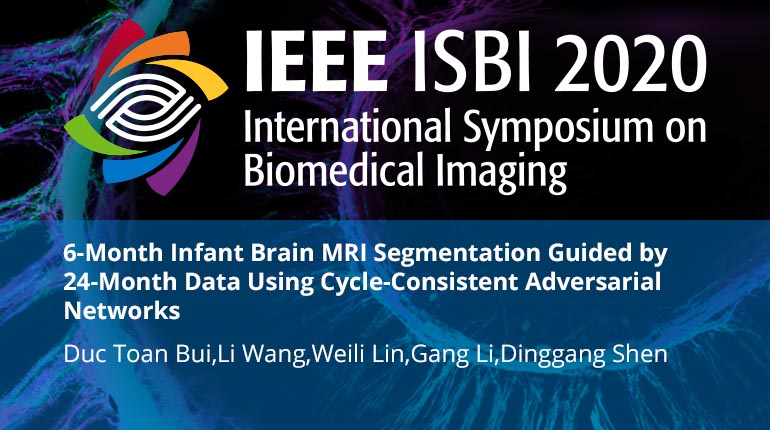
Already purchased this program?
Login to View
This video program is a part of the Premium package:
6-Month Infant Brain MRI Segmentation Guided by 24-Month Data Using Cycle-Consistent Adversarial Networks
- IEEE MemberUS $11.00
- Society MemberUS $0.00
- IEEE Student MemberUS $11.00
- Non-IEEE MemberUS $15.00
6-Month Infant Brain MRI Segmentation Guided by 24-Month Data Using Cycle-Consistent Adversarial Networks
Due to the extremely low intensity contrast between the white matter (WM) and the gray matter (GM) at around 6 months of age (the isointense phase), it is difficult for manual annotation, hence the number of training labels is highly limited. Consequently, it is still challenging to automatically segment isointense infant brain MRI. Meanwhile, the contrast of intensity images in the early adult phase, such as 24 months of age, is a relatively better, which can be easily segmented by the well-developed tools, e.g., FreeSurfer. Therefore, the question is how could we employ these high-contrast images (such as 24-month-old images) to guide the segmentation of 6-month-old images. Motivated by the above purpose, we propose a method to explore the 24-month-old images for a reliable tissue segmentation of 6-month-old images. Specifically, we design a 3D-cycleGAN-Seg architecture to generate synthetic images of the isointense phase by transferring appearances between the two time-points. To guarantee the tissue segmentation consistency between 6-month-old and 24-month-old images, we employ features from generated segmentations to guide the training of the generator network. To further improve the quality of synthetic images, we propose a feature matching loss that computes the cosine distance between unpaired segmentation features of the real and fake images. Then, the transferred of 24-month-old images is used to jointly train the segmentation model on the 6-month-old images. Experimental results demonstrate a superior performance of the proposed method compared with the existing deep learning-based methods.
Due to the extremely low intensity contrast between the white matter (WM) and the gray matter (GM) at around 6 months of age (the isointense phase), it is difficult for manual annotation, hence the number of training labels is highly limited. Consequently, it is still challenging to automatically segment isointense infant brain MRI. Meanwhile, the contrast of intensity images in the early adult phase, such as 24 months of age, is a relatively better, which can be easily segmented by the well-developed tools, e.g., FreeSurfer. Therefore, the question is how could we employ these high-contrast images (such as 24-month-old images) to guide the segmentation of 6-month-old images. Motivated by the above purpose, we propose a method to explore the 24-month-old images for a reliable tissue segmentation of 6-month-old images. Specifically, we design a 3D-cycleGAN-Seg architecture to generate synthetic images of the isointense phase by transferring appearances between the two time-points. To guarantee the tissue segmentation consistency between 6-month-old and 24-month-old images, we employ features from generated segmentations to guide the training of the generator network. To further improve the quality of synthetic images, we propose a feature matching loss that computes the cosine distance between unpaired segmentation features of the real and fake images. Then, the transferred of 24-month-old images is used to jointly train the segmentation model on the 6-month-old images. Experimental results demonstrate a superior performance of the proposed method compared with the existing deep learning-based methods.
 Cart
Cart Create Account
Create Account Sign In
Sign In





